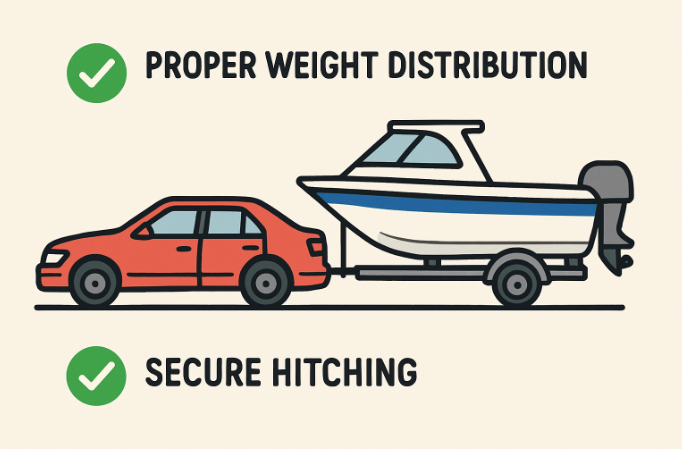Table of Contents
- Pre-Trip Inspection
- Proper Weight Distribution
- Hitching and Lighting
- Driving Techniques
- Regular Maintenance
- Emergency Preparedness
Hauling your boat safely and efficiently is key to protecting your investment and ensuring a stress-free experience on the road. Whether you’re heading out for a weekend fishing trip or transporting your craft for storage, being prepared can make all the difference. Anyone new to boating or looking to upgrade their setup can find valuable information in this boat trailer buying guide Glen Burnie MD, which helps you choose the right trailer and gear for your specific needs.
From meticulously checking your trailer and vehicle before every trip to mastering weight distribution, following best practices saves you time and keeps your journey safe. Proper hitching, reliable lighting, and adjusted driving techniques go a long way in preventing accidents or breakdowns. No matter your level of experience, this guide will help you tow with confidence and peace of mind.
Pre-Trip Inspection
Taking ten minutes before every trip to inspect your boat trailer and tow vehicle is one of the most important safety steps you can take. Check the tire pressure and tread on both the trailer and vehicle, looking for any uneven wear or damage that could signal a future blowout. Ensure all lights—including tail, brake, and turn indicators—are functioning properly, and that your side mirrors are clean and properly adjusted for clear visibility. Tighten the lug nuts and ensure all fasteners and safety chains are secure.
Inspect the trailer frame, hitch components, and wiring for signs of corrosion. Address any rust or weakness right away, as even minor defects can become major safety risks at highway speeds. Performing a walk-around with a checklist each time you haul can prevent accidents and costly repairs along the way.
Proper Weight Distribution
Achieving the right balance on your boat trailer is essential to prevent sway and maintain vehicle control. Aim to load about 60% of the total weight toward the front half of the trailer, directly over or slightly ahead of the trailer axle, and the remaining 40% toward the back. This position helps keep the tongue weight—typically 10-15% of the total trailer weight—within a safe range for your vehicle’s hitch capacity.
Secure the boat to the trailer using ratchet straps, bow eyes, and winch lines, ensuring there is no possibility of movement. Avoid loading heavy gear at the very rear, as this can reduce traction on your vehicle’s rear wheels and result in dangerous fishtailing.
Hitching and Lighting
Secure hitching is non-negotiable for safe boat trailering. Match the hitch size to your trailer’s coupler, and lower the coupler fully onto the hitch ball until it locks in place. Always cross the safety chains underneath the tongue; this creates a cradle to catch the tongue should the coupler detach. Ensure that breakaway cables, if present, are properly attached directly to your tow vehicle for added safety.
After attaching the trailer, connect the wiring harness and verify all lighting circuits by having a partner confirm that the running lights, brake lights, and turn signals function correctly. Reliable visibility is a legal requirement and critical to your safety—especially in poor weather or low light conditions.
Driving Techniques
Towing a boat trailer changes your vehicle’s handling, acceleration, and stopping distances. Start by increasing your following distance to at least double what you would allow without a trailer, and anticipate stops and turns well in advance. Take corners in a wider arc to avoid clipping curbs or hitting obstacles with the trailer wheels. Sudden maneuvers can lead to trailer sway or jackknifing, so always opt for smooth, steady steering and braking.
Practice basic maneuvers, such as backing up and turning, in an empty parking lot before your first trip. Becoming familiar with your trailer’s tracking and pivot points is essential, especially on narrow roads or around crowded launch ramps.
Regular Maintenance
Routine maintenance doesn’t just protect your equipment; it keeps you and your fellow motorists safe. After each use, rinse the trailer thoroughly with fresh water to remove salt, sand, or dirt. This prevents corrosion and extends the trailer’s lifespan. At regular intervals, check and grease the wheel bearings, inspect the tires for sidewall cracks or uneven wear, and ensure the brakes are working as intended. Keep suspension components lubricated and replace parts that show signs of interference or rust.
Schedule a yearly inspection with a qualified mechanic, especially if you use your trailer frequently or travel long distances. Proactive upkeep minimizes the risk of breakdowns that could leave you stranded or cause hazardous situations on busy roads.
Emergency Preparedness
Even with the best preparations, emergencies can occur. Equip your tow vehicle with a kit containing a spare tire, lug wrench, jack, flares, reflective triangles, jumper cables, and a first-aid kit. Pack drinking water, gloves, and a flashlight in case you have to address issues after dark or in remote areas. Review your route for access to gas stations, repair shops, and rest stops, especially on longer journeys.
Having roadside assistance coverage that includes trailers can provide invaluable peace of mind. In the event of a mechanical breakdown or accident, knowing who to call and being able to describe your location will expedite help and keep everyone safe.
By combining diligent pre-trip checks, correct loading, secure hitching, smart driving, regular maintenance, and a solid emergency plan, you guarantee the best boating adventures—all starting with safe and easy trailer hauling.

